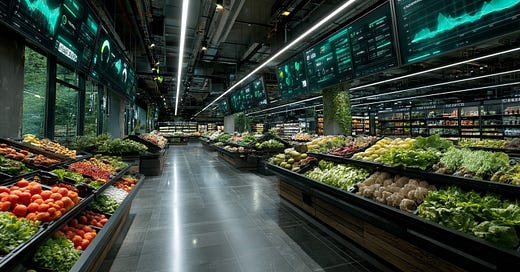What can grocery AI teach manufacturing, healthcare, and financial services leaders? Here are 9 strategic lessons from the $136 billion grocery AI transformation that apply across ALL industries.
What's in This Report
This briefing examines how grocery retailers are implementing AI and what other executives can learn from their experience. It's based on industry data showing a $136 billion value opportunity and documented results from major retailers.
What You'll Learn:
Where the money is: Supply chain AI creates significantly more value ($67.7B) than customer-facing applications
Real costs and returns: ROI data showing 18-month payback periods and what companies are spending
What's working: Specific examples from Walmart, Amazon, and Kroger implementations
Major risks: The five biggest AI implementation risks and what they cost to fix
Cross-Industry Application:
Nine lessons from grocery that apply to manufacturing, healthcare, finance, and other sectors
Why backend operational AI typically outperforms customer-facing AI investments
How early adopters gain advantages while late movers face higher costs
Practical Tools:
Implementation timeline with 30-60-90 day steps
Risk assessment framework you can adapt for your industry
Four charts suitable for board presentations
Bottom Line: A realistic look at one industry's AI transformation with lessons you can apply to your own sector. Shows what actually works, what doesn't, and what it costs.
Executive Summary
Artificial intelligence is fundamentally reshaping the grocery industry, with AI projected to unlock $136 billion in value across the grocery sector by 2030¹. However, the real transformation is happening where customers never look: in supply chains, inventory management, and operational efficiency.
While the industry focuses on flashy customer-facing technologies like cashier-less stores, the largest value creation opportunity lies in backend operations. Supply chain and logistics represent $67.7 billion of the total opportunity, followed by merchandising at $25.7 billion¹. Early adopters are already seeing dramatic results, with some retailers achieving 15-30% efficiency gains and waste reductions exceeding 35%.
Grocers are expecting a 12x increase in technology spending on AI by 2030, with 84% planning to embed AI in most or all of their technologies². Only companies with sophisticated data infrastructure and strategic implementation will capture the full value. The industry is splitting into AI-enabled leaders and traditional laggards, with potentially irreversible competitive gaps emerging.
Bottom Line: Companies that master AI-driven supply chain optimization within the next 18 months will establish sustainable competitive advantages. Those that wait will face margin compression and market share erosion against algorithmically superior competitors.
Keep reading with a 7-day free trial
Subscribe to The Drew Report - AI Strategy for Executives to keep reading this post and get 7 days of free access to the full post archives.





